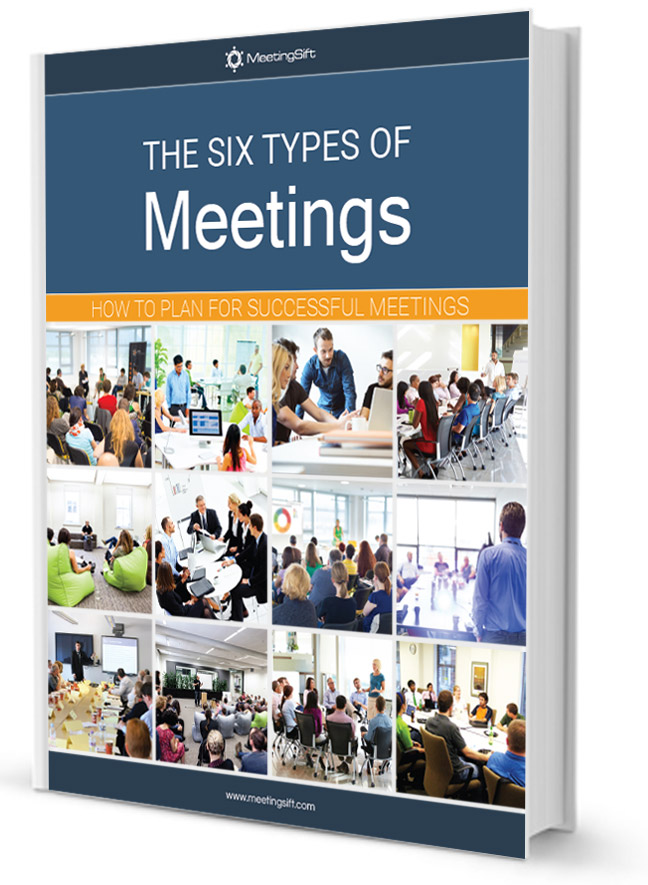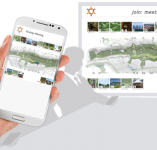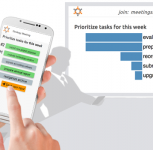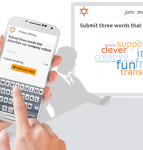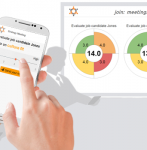Problem Solving Meetings are oriented around solving either a specific or general problem, and are perhaps the most complex and varied type of meetings.
 Whether the meeting is addressing an identified problem, or it is focusing on creating strategies and plans to navigate the future, there are a rich arsenal of group processes that can be used. Scopes and priorities need to be defined, opportunities and threats need to be identified, and possible solutions should be brainstormed, evaluated, and agreed upon.
Whether the meeting is addressing an identified problem, or it is focusing on creating strategies and plans to navigate the future, there are a rich arsenal of group processes that can be used. Scopes and priorities need to be defined, opportunities and threats need to be identified, and possible solutions should be brainstormed, evaluated, and agreed upon.
At problem solving meetings the outcome is often an important decision and thus these meetings can be crucial to the development of a team or product. If the wrong action is chosen, it could be hugely damaging. To make sure that this doesn’t happen at your next problem solving meeting, follow the tips provided here.
Primary Goals in Problem Solving Meetings
The goal underlying these meetings is to leave with a new strategy designed to counter a current issue preventing or hindering the team’s progress.
The key objective for problem solving meetings is to find the most optimal solution or reach the best compromise that can resolve an issue facing the group or organization. In order to do this the group first has to identify possible solutions, and then evaluate these based on relevant requirements and criteria.
Agreeing on the most optimal solution
What truly is the most optimal solution can vary a lot, depending on the setting and situation. It is important to clearly define what the problem is, as well as agree on key criteria for the solution, in order to start identifying possible options.
Sometimes the best solution is the quickest one, other times it is the one that requires the least resources, while other times the solution that brings the most long term benefits is the best alternative. If all planning decisions were made by one person, not only would the choices be uninformed, there would also be little unity around team goals and direction.
Key Roles in Problem Solving Meetings
Problem solving meetings should be oriented around issues that affect and are only resolvable by the team. If a problem is the responsibility of, or can be fixed by one person, a group meeting is likely a waste of time. However, when a singular person’s decision affects that of the entire team, it may be worth it.
The significance of a problem and the amount of group time spent solving it should be considered before calling forth any group problem solving meeting. The participant roles found in a problem solving meeting tend to vary more than most other meeting types. This is because problem solving meetings exist across such a large variety of contexts and group.
Meeting leader
Just as with decision making meetings, there is a need for direction and authority in the process of problem solving. The person in charge should either be the person with the deepest understanding of the situation or someone with the most responsibility over the outcome (i.e. the highest ranking member of the team). The leader should be able to provide the team with a general overview of the situation. They should then lead the team through the guided process.
Meeting participants
All other attendees of the meeting should be people who fall under two categories. The first is of participants who may have been involved in the events leading up to the problem. This group is not there to be blamed or criticized, but rather to provide information about how the situation was reached. In addition, this group has unique insights on how potential solutions may or may not fit with the current approach.
The second group of people who should be invited are those who will be impacted by the solution. If, for example, one subgroup of a company has to restructure the timing of their releases, representatives from other groups who will have to adapt their schedule as a result should be included.
Common Challenges in Problem Solving Meetings
Often the most successful problem solving meetings are ones that happen before a major issue arises. Taking time to identify potential future problems allows a team to have solutions immediately ready. Unfortunately, problem solving meetings are all too often done only after a problem occurs, adding a variety of challenges that would not exist in other meeting types.
Problem solving can be a particularly stressful type of group strategizing. For instance, the urgency and decisiveness that is necessary in this meeting type can lead to disagreements that wouldn’t happen if teammates were not strained.
Identifying the real problem
Identifying the true problem to be addressed can on the surface seem like a very simple task. However, different meeting participants are likely to have slightly different perspectives of what they are gathered to address. Without a common understanding of what problem they are aiming to solve, the problem solving meeting is not going to yield any productive solutions.
Intra-group conflicts
With any problem solving or decision making meeting there is bound to be some conflicting opinions on how to go forward. Because problem solving meetings are often high strung, and because of the importance of selecting a correct plan, resolving these conflicts effectively is crucial. When making group decisions, a number of different strategies can be used to reach a compromise.
Defensiveness
When any type of group decision needs to be made, participants in the process can become too attached to their own suggestion to truly consider other options. While this leads to a lot of passionate and potentially productive conversation, it can also lead members to feel personally offended when their solutions are rejected.
Time pressure
Often problem meetings are extremely time-constrained. This can be because the problem is an approaching deadline or because there was simply no time scheduled in the initial plan for a problem to arise
How to Host Successful Problem Solving Meetings
The best way to approach a problem solving meeting is to first properly define the problem and the restrictions of potential solutions. Before brainstorming solutions, evaluate them, and decide on the best one.
Identify the problem to be addressed
The first key step to solving any problem is to identify the issue at hand. Problem solving meetings are designed to address any type of situation specific to the group. Determining what the problem is may be easier if it has already become a pressing issue. However, problem solving meetings can also be designed to generate preemptive solutions to problematic situations that may arise in the future. Regardless, any problem solving meeting should begin with a discussion of the specific issues that need to be changed or resolved by the end of the meeting.
Often, when a pervasive issue exists within a group, .some members are more aware of it than others. Beginning a problem solving meeting by explicitly identifying the issue not only makes clear what the meeting goals are, but also puts all team members on the same page about the state of the group or project. Identifying this problem early on also gives the team the ability to modify the topics or members involved in reaching a solution.
Define solution requirements and restraints
Once a problem has been identified, the group should propose all possible ways to approach and resolve the issue. The reason why problem solving is often easier said than done is because of existing restraints that withhold many of the ideal options available. For example, these restrictions could involve a lack of time or a lack of corporate resources. These restraints are important to consider because problems often result as a lack of consideration for them in the first place.
Brainstorm possible solutions
To choose among feasible solutions, it is important to define not only the possible limitations but also where group priorities lie. The most effective choices are made once the team’s understanding of the most urgent aspects of a future decision have been defined. Without a realistic idea of which aspects are most important, the solutions proposed will either be unrealistic or oriented around personal opinions. This step in the problem solving methodology allows for the most important and realistic strategies to be the ones most discussed.
Evaluate top solutions
After the feasible solutions to a problem have been isolated, the group must come to a collective conclusion about the best approach. This process should involve group consideration and evaluation of proposed options. It can be important to highlight and compare potential options against each other. For example, depending on the priorities of the group, an option which extends the timeline might be preferable to one that sacrifices quality or vice versa.
Agree on a solution
The best and most appropriate options that are generated during this meeting should be approached in the same way as options within a decision making meeting. Feedback, opinions and questions about each strategy should be considered and everyone involved in the meeting should feel free to voice their opinions. The final decision should be one that is not only realistic but that puts the entire team on the same page going forward.
Better Problem Solving Meetings with MeetingSift
MeetingSift’s brainstorm activity can help determine the problem, identify restrictions, and come up with ideas for possible solutions. The polling and ranking activities can then give an overview of where the group’s opinions lie. Using these tools can relieve not only the above mentioned problems but many others that are associated with problem solving meetings.
Gather honest opinions through anonymous feedback
The anonymous contribution platform that MeetingSift provides allows for more candid feedback, as well as helping the group to focus on the issue rather than the person.
Not only does this lead participants to be less upset when their ideas are not chosen, but also to not feel like they must support one particular solution or plan just because it was proposed by someone with authority in the group. In short, MeetingSift allows for the group to focus on the problem solving process rather than office politics.
Cut meeting time with parallel input
With MeetingSift, group polls can be conducted and decisions made in a fraction of the time that it usually takes to collect that amount of information. Additionally, MeetingSift allows facilitators to time the duration of their slides and activities in order to cut down and condense unnecessary aspects of the conversation.
Efficiently identify solutions or acceptable compromises
With problem solving meetings we suggest using an empirical voting tool such as ranking or voting to choose a winner, rather than trying to find a compromise between the two. In the face of a problem at hand, it is often best to choose and stick with one dominant strategy.
Easily record and share the final solution
While these opinions should be incorporated in the process, MeetingSift reports serve as a useful tool to share the solution decisions with as many other people as possible.



